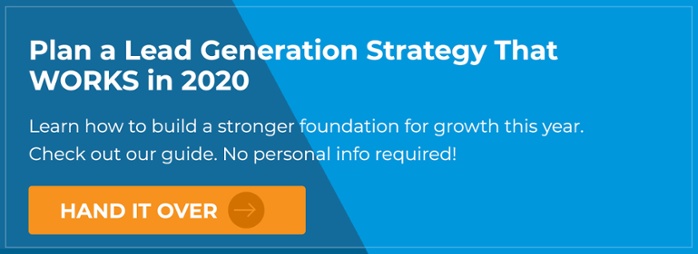
5 Questions To Help You Improve Your Healthcare Blog Topic Ideas
Patrick Dodge
Founder
Are the blog topics in your content calendar driving real growth for your healthcare brand? Do you wonder how you could make them better?
Even the most successful marketers sometimes struggle to keep their blog content fresh and results-focused. We're all taking baby steps forward when it comes to content marketing.
With that in mind, I'm going to share a few questions that have helped us fend off unproductive ideas and keep the good ones aligned with our long term growth strategy.
First, a quick review of the basics...
What is a Blog For?
A blog attracts the right people to your website and helps them solve problems.
In the process, you can accomplish a number of things. You will build trust as you teach your audience. You will keep people engaged and demonstrate your brand expertise, instilling confidence that your team knows what they are doing.
You will also reduce the time your sales team spends answering the same questions buyers ask over and over again. Every content strategy should cover questions your prospects ask all the time, and they usually revolve around the same types of things:
- What does it cost?
- How long will it take?
- What other solutions might fit my needs?
These FAQs become evergreen posts in healthcare blogs, and they can provide tremendous value to your buyers and your sales team.
Lastly, your company blog can also help you qualify leads. When you're blogging on a regular basis, you are not speaking to just anybody out there. You are speaking directly to your buyer persona.
It's important to structure your content in a way that speaks to the needs of your buyers, and weed out people that are not a great fit.
What Should Healthcare Brands Blog About?
This should go without saying in 2021, but the first rule about business-to-business (B2B) blogging is thou shalt not try to sell to your visitors.
There's a lot of content out there. If you start trying to sell to people in your blog, you will make it very easy for them to look for elsewhere for useful information.
Focus on your buyers and their challenges in your blog -- not your solutions.
If you do it right and increase traffic to your website, you will get new business. There's a strategy here. But if you're treating your blog like a glorified PR message board, you are going to lose people quickly. I've seen it happen.
Now, let's talk about the five key questions that will help you keep blog topics aligned with your brand's marketing strategy.
Related Content: What Should You Pay for a Blog Post?
1. What is the Campaign?
Campaigns drive the growth of your business.
Every blog article, social media post, landing page, and call-to action on your website should be tied to a campaign designed to advance your business goals. This is easy to implement if you are using a marketing automation platform like HubSpot, and it's very useful for measuring performance.
Grouping these marketing assets under campaigns will help you determine how many contacts are influenced by your blog and what ROI looks like.

2. Who is the Buyer Persona?
Your buyer persona is your core audience, the people your company sells products and services to.
Your brand might have more than one persona – you’ll know this if the decision making criteria and other important factors vary from one set of buyers to the next – and this is why it’s important to define which one your topic is meant for.
You will need documented insights about how your buyers make decisions in order to keep your content ideas aligned with their expectations. These “buying insights” should include:
- What happens that makes them abandon the status quo and search for your solution?
- Where do they look for options, and what influences their decision along the way?
- What is most important to them as they compare the features and benefits of different options?
- What do they hope to gain personally or professionally by investing in a solution?
- What did they see and hear during the evaluation that made them decide some providers were not a good fit?
These insights can be gained by finding buyers who don’t have a previous relationship with your brand and interviewing them about a previous buying experience.
Don’t go to your salespeople or your customers for this information. You will always get biased answers that won’t give you a clear picture of what really happens behind the scenes.
When it comes to buyer insights -- you want the unvarnished truth, and nothing but.
3. What Stage of the Buyer's Journey is It For?
Next, we need to consider the lifecycle stage your buyer persona will be in when they read the blog post, and how this topic will help them move forward in their journey.
The three stages to the buyer's journey are defined as awareness, consideration, and decision.

In the awareness stage, your persona is experiencing a specific challenge they are starting to research. If the topic is meant for the awareness phase, you're going to provide basic information that helps your persona better understand the challenge they are facing and lay the groundwork for possible solutions.
If your persona is in the consideration stage, they’re evaluating possible solutions and trying to decide which one is right for their practice. Comparison posts that highlight the pros and cons of different approaches are a great way to engage your audience in the consideration stage.
All the blog topics you create for the awareness and consideration stage are designed to guide good-fit leads to the decision stage, which is the point where they show interest in talking with one of your salespeople.
4. What is the Call-to-Action?
The last, and perhaps the most important consideration when planning your blog topics is the call-to-action you're putting in the post.
A call-to-action (CTA) is a button, graphic, or text link embedded within the blog article that features a relevant offer to your reader. A good CTA should present your persona with a compelling “next step” in their learning, whether it’s downloading a guide or connecting with specialist for a consultation.
If I'm on your website reading an article about vitamin D, you may want to show me an offer to download your amazing bone health protocol. You would concisely summarize the benefits in the CTA and place it in a few places on the page. When I click on it, the CTA takes me from the blog to a landing page that describes this great downloadable content I’m about to get.
It might be a guide, or a template, or something else that's hyper-relevant to what I’m reading about. Whatever form the offer takes, it needs to be valuable enough for people to engage your brand on a more personal level, usually by filling out a form.
It's important to decide which call-to-action you are going to use before planning your blog topic.
By aligning the two, you will improve your chances of converting a visitor into a good-fit prospect. One way you can do this is by creating your downloadable content offer, and then working backwards by making a list of topics you can feed into it.
For example, a comprehensive guide about “How to Manage High Cortisol in Your Patients” could spur many useful topics like:
- What Are the Signs of High Cortisol?
- 3 Stages of Stress Response in the Body
- Nutrients that Promote Healthy Cortisol Levels
These ideas would make highly informative blog posts and present a great opportunity to use your cortisol guide offer to convert readers into leads.
Every piece in your content framework should play a role in the broader strategy to establish a deeper connection with your buyers.
"Focus on your buyers and their challenges in your blog -- not your solutions.
If you do it right and increase traffic to your website, you will get new business."
5. How Will Keywords + Context Get Your Blog Found?
It's more difficult than ever to get your website to rank on Google today.
The internet is exploding with content, and SEO competition is increasingly fierce for all industries. Healthcare is no exception.
Despite this, keyword research is still a vital part of a smart content strategy. The key thing to remember today is context.
Keyword Value + Context = Success
Google has evolved into such an efficient research machine it provides answers to questions in "snippets" right there on the search results page. You don’t even have to click a link to get information anymore (bad news for marketers).
The lesson to be learned from this trend? Context is increasingly important for search engine optimization.
People search by using questions, not keywords. Just ask Alexa!
Should still use long-tail keyword phrases in your titles, but also make sure your topic matches the “search intent” buyers use as they hunt for information online.
No matter what keywords you have in mind for your article, it's important to do a few searches and just get a sense of the context of around this topic. The context should also match the needs of your buyer persona, their lifecycle stage, and your campaign elements. All these things should come together in your planning.
As you systemize this process and filter your blog topics through these five questions, you will deliver greater value to your audience, gain better data about your campaign performance, and boost your brand’s lead generation at the same time.
You will have a much stronger foundation for your long term growth strategy, and ensure your brand has a productive blog that will produce results for years to come.
May 20, 2021 8:51:41 AM


